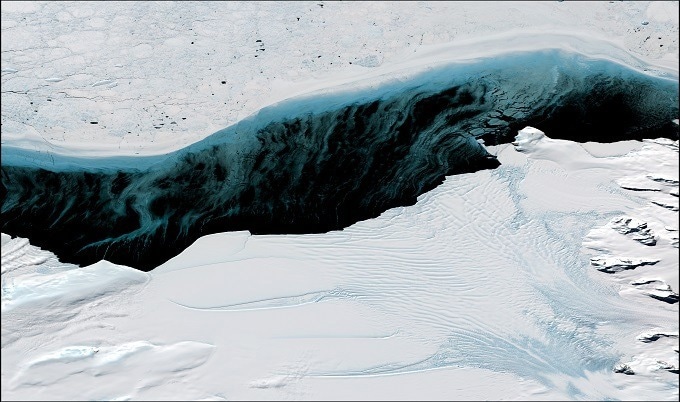During periods of climate warming, ice sheets can retreat up to 600 m per day, which is 20 times faster than the maximum rate of retreat ever documented.
 Landsat 8 image showing the highly dynamic SCAR Inlet Ice Shelf, Antarctica & sea ice production offshore. Image Credit: NASA/USGS, processed by Dr. Frazer Christie.
Landsat 8 image showing the highly dynamic SCAR Inlet Ice Shelf, Antarctica & sea ice production offshore. Image Credit: NASA/USGS, processed by Dr. Frazer Christie.
Preserved Glacial Landforms
An international team of scientists headed by Dr. Christine Batchelor of Newcastle University in the United Kingdom used high-resolution imagery of the seafloor to demonstrate how swiftly a previous ice sheet that spanned from Norway retreated during the end of the last Ice Age, some 20,000 years ago.
The group, which included experts from the universities of Cambridge and Loughborough in the United Kingdom, as well as the Geological Survey of Norway, documented almost 7,600 small-scale features known as “corrugation ridges” across the bottom. The ridges are less than 2.5 m in height and spaced 25 to 300 m apart.
These landforms are believed to have formed when the retreating margin of the ice sheet moved up and down with the tides, driving seafloor sediments into a ridge with each low tide. Given that two ridges would have formed each day (assuming two tidal cycles each day), the researchers calculated how quickly the ice sheet would have retreated.
The findings, published in the journal Nature, demonstrate that the former ice sheet experienced pulses of fast retreat at speeds ranging from 50 to 600 m per day.
This is substantially faster than any rate of ice sheet retreat recorded from satellites or inferred from analogous landforms in Antarctica.
Our research provides a warning from the past about the speeds that ice sheets are physically capable of retreating at. Our results show that pulses of rapid retreat can be far quicker than anything we’ve seen so far.
Dr. Christine Batchelor, Newcastle University
The ability to anticipate future ice-sheet and sea-level rise requires knowledge of how ice sheets acted during previous episodes of climate warming.
“This study shows the value of acquiring high-resolution imagery about the glaciated landscapes that are preserved on the seafloor,” says study co-author Dr. Dag Ottesen from the Geological Survey of Norway. Dr. Dag Ottesen is also involved in the MAREANO seafloor mapping program that gathered the data.
Pulses of Rapid Retreat
The new research implies that instances of such fast ice-sheet retreat may only last for brief periods of time (days to months).
This shows how rates of ice-sheet retreat averaged over several years or longer can conceal shorter episodes of more rapid retreat. It is important that computer simulations are able to reproduce this ‘pulsed’ ice-sheet behavior.
Julian Dowdeswell, Study Co-Author and Professor, Scott Polar Research Institute, University of Cambridge
The seafloor landforms also shed light on the process that allows for such rapid retreat. The former ice sheet receded fastest across the flattest areas of its bed, according to Dr. Batchelor and co-workers.
An ice margin can unground from the seafloor and retreat near-instantly when it becomes buoyant. This style of retreat only occurs across relatively flat beds, where less melting is required to thin the overlying ice to the point where it starts to float.
Dr. Frazer Christie, Study Co-Author, Scott Polar Research Institute
Implications for Antarctica
The scientists conclude that similar fast retreat pulses could be detected in portions of Antarctica in the near future. This includes the massive Thwaites Glacier in West Antarctica, which is the subject of extensive worldwide investigation due to its potential for destabilizing retreat.
Because Thwaites Glacier has lately retreated close to a flat portion of its bed, the authors of this new study believe it may experience a pulse of fast retreat.
“Our findings suggest that present-day rates of melting are sufficient to cause short pulses of rapid retreat across flat-bedded areas of the Antarctic Ice Sheet, including at Thwaites. Satellites may well detect this style of ice-sheet retreat in the near-future, especially if we continue our current trend of climate warming,” notes Dr Batchelor.
Dr Aleksandr Montelli and Evelyn Dowdeswell at the Scott Polar Research Institute of the University of Cambridge, Dr Jeffrey Evans at Loughborough University, and Dr Lilja Bjarnadóttir at the Geological Survey of Norway also took part in the study.
The research was funded by the Faculty of Humanities and Social Sciences at Newcastle University, Peterhouse, Cambridge, the Prince Albert II of Monaco Foundation, and the Geological Survey of Norway.
Journal Reference:
Batchelor, C. L., et al. (2023). Rapid, buoyancy-driven ice-sheet retreat of hundreds of metres per day. Nature. doi.org/10.1038/s41586-023-05876-1.